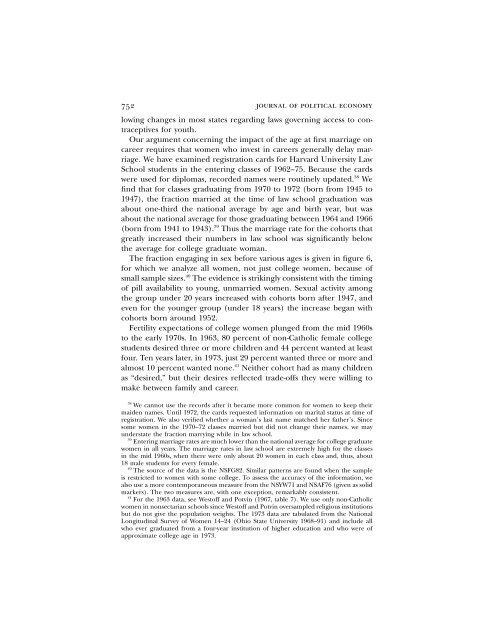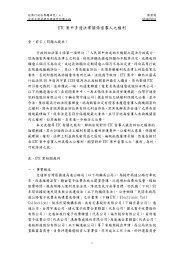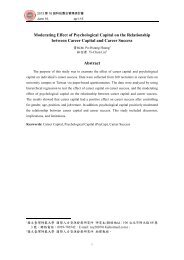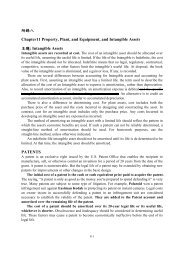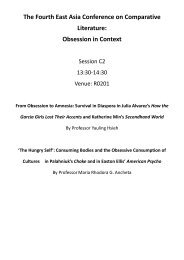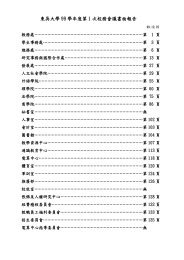The Power of the Pill: Oral Contraceptives and Women's ... - Mail
The Power of the Pill: Oral Contraceptives and Women's ... - Mail
The Power of the Pill: Oral Contraceptives and Women's ... - Mail
You also want an ePaper? Increase the reach of your titles
YUMPU automatically turns print PDFs into web optimized ePapers that Google loves.
752 journal <strong>of</strong> political economy<br />
lowing changes in most states regarding laws governing access to contraceptives<br />
for youth.<br />
Our argument concerning <strong>the</strong> impact <strong>of</strong> <strong>the</strong> age at first marriage on<br />
career requires that women who invest in careers generally delay marriage.<br />
We have examined registration cards for Harvard University Law<br />
School students in <strong>the</strong> entering classes <strong>of</strong> 1962–75. Because <strong>the</strong> cards<br />
were used for diplomas, recorded names were routinely updated. 38 We<br />
find that for classes graduating from 1970 to 1972 (born from 1945 to<br />
1947), <strong>the</strong> fraction married at <strong>the</strong> time <strong>of</strong> law school graduation was<br />
about one-third <strong>the</strong> national average by age <strong>and</strong> birth year, but was<br />
about <strong>the</strong> national average for those graduating between 1964 <strong>and</strong> 1966<br />
(born from 1941 to 1943). 39 Thus <strong>the</strong> marriage rate for <strong>the</strong> cohorts that<br />
greatly increased <strong>the</strong>ir numbers in law school was significantly below<br />
<strong>the</strong> average for college graduate woman.<br />
<strong>The</strong> fraction engaging in sex before various ages is given in figure 6,<br />
for which we analyze all women, not just college women, because <strong>of</strong><br />
small sample sizes. 40 <strong>The</strong> evidence is strikingly consistent with <strong>the</strong> timing<br />
<strong>of</strong> pill availability to young, unmarried women. Sexual activity among<br />
<strong>the</strong> group under 20 years increased with cohorts born after 1947, <strong>and</strong><br />
even for <strong>the</strong> younger group (under 18 years) <strong>the</strong> increase began with<br />
cohorts born around 1952.<br />
Fertility expectations <strong>of</strong> college women plunged from <strong>the</strong> mid 1960s<br />
to <strong>the</strong> early 1970s. In 1963, 80 percent <strong>of</strong> non-Catholic female college<br />
students desired three or more children <strong>and</strong> 44 percent wanted at least<br />
four. Ten years later, in 1973, just 29 percent wanted three or more <strong>and</strong><br />
almost 10 percent wanted none. 41 Nei<strong>the</strong>r cohort had as many children<br />
as “desired,” but <strong>the</strong>ir desires reflected trade-<strong>of</strong>fs <strong>the</strong>y were willing to<br />
make between family <strong>and</strong> career.<br />
38<br />
We cannot use <strong>the</strong> records after it became more common for women to keep <strong>the</strong>ir<br />
maiden names. Until 1972, <strong>the</strong> cards requested information on marital status at time <strong>of</strong><br />
registration. We also verified whe<strong>the</strong>r a woman’s last name matched her fa<strong>the</strong>r’s. Since<br />
some women in <strong>the</strong> 1970–72 classes married but did not change <strong>the</strong>ir names, we may<br />
understate <strong>the</strong> fraction marrying while in law school.<br />
39<br />
Entering marriage rates are much lower than <strong>the</strong> national average for college graduate<br />
women in all years. <strong>The</strong> marriage rates in law school are extremely high for <strong>the</strong> classes<br />
in <strong>the</strong> mid 1960s, when <strong>the</strong>re were only about 20 women in each class <strong>and</strong>, thus, about<br />
18 male students for every female.<br />
40<br />
<strong>The</strong> source <strong>of</strong> <strong>the</strong> data is <strong>the</strong> NSFG82. Similar patterns are found when <strong>the</strong> sample<br />
is restricted to women with some college. To assess <strong>the</strong> accuracy <strong>of</strong> <strong>the</strong> information, we<br />
also use a more contemporaneous measure from <strong>the</strong> NSYW71 <strong>and</strong> NSAF76 (given as solid<br />
markers). <strong>The</strong> two measures are, with one exception, remarkably consistent.<br />
41<br />
For <strong>the</strong> 1963 data, see West<strong>of</strong>f <strong>and</strong> Potvin (1967, table 7). We use only non-Catholic<br />
women in nonsectarian schools since West<strong>of</strong>f <strong>and</strong> Potvin oversampled religious institutions<br />
but do not give <strong>the</strong> population weights. <strong>The</strong> 1973 data are tabulated from <strong>the</strong> National<br />
Longitudinal Survey <strong>of</strong> Women 14–24 (Ohio State University 1968–91) <strong>and</strong> include all<br />
who ever graduated from a four-year institution <strong>of</strong> higher education <strong>and</strong> who were <strong>of</strong><br />
approximate college age in 1973.


